Incorporating Patient Preferences into a Decision-Making Model of Hand Trauma Reconstruction
Abstract
:1. Introduction
2. Materials and Methods
2.1. CA: Attribute and Value Level Determination
2.2. Analysis and Statistics
3. Results
3.1. Characteristics of Participants
3.2. Preference Level Evaluation
3.3. Cluster Analysis
3.4. Proposed Decision-Making Model
4. Discussion
5. Conclusions
Author Contributions
Funding
Institutional Review Board Statement
Informed Consent Statement
Data Availability Statement
Acknowledgments
Conflicts of Interest
Appendix A
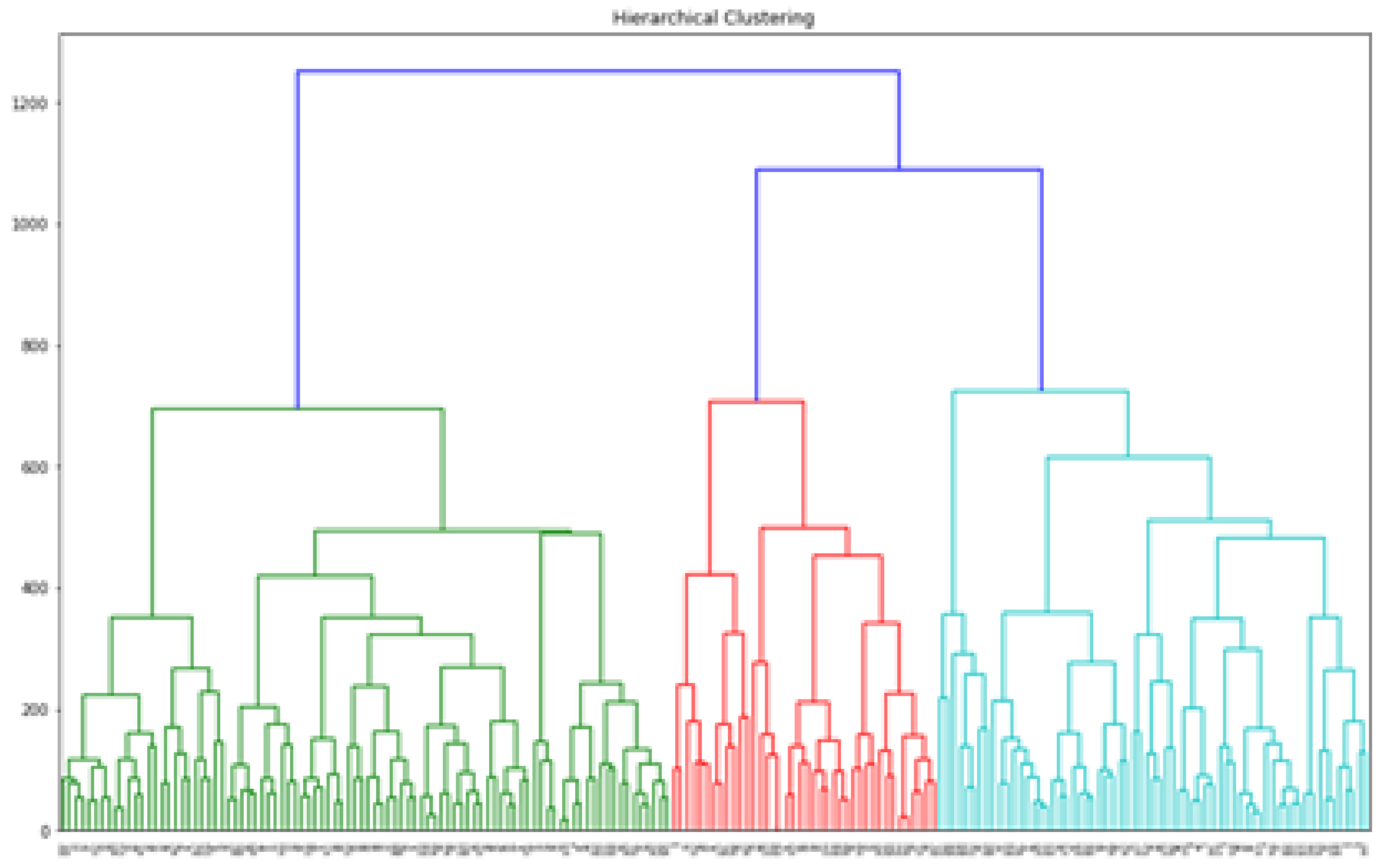
References
- Sprague, S.; McKay, P.; Thoma, A. Study Design and Hierarchy of Evidence for Surgical Decision Making. Clin. Plast. Surg. 2008, 35, 195–205. [Google Scholar] [CrossRef] [PubMed]
- Pauker, S.G. Medical Decision Making: How Patients Choose. Med Decis. Mak. 2010, 30, 8–10. [Google Scholar] [CrossRef] [PubMed]
- Ryan, M.; Farrar, S. Using conjoint analysis to elicit preferences for health care. BMJ 2000, 320, 1530–1533. [Google Scholar] [CrossRef] [Green Version]
- Wilke, T. Patient preferences for an oral anticoagulant after major orthopedic surgery: Results of a German survey. Patient 2009, 2, 39–49. [Google Scholar] [CrossRef]
- Harris, C.A.; Shauver, M.J.; Yuan, F.; Nasser, J.; Chung, K.C. Understanding Patient Preferences in Proximal Interphalangeal Joint Surgery for Osteoarthritis: A Conjoint Analysis. J. Hand Surg. 2018, 43, 615–624. [Google Scholar] [CrossRef]
- Hampson, L.A.; Allen, I.E.; Gaither, T.W.; Lin, T.; Ting, J.; Osterberg, E.C.; Wilson, L.; Breyer, B.N. Pa-tient-centered treatment decisions for urethral stricture: Conjoint analysis improves surgical decision-making. Urology 2017, 99, 246–253. [Google Scholar] [CrossRef] [Green Version]
- De Das, S.; Sebastin, S.J. Considerations in Flap Selection for Soft Tissue Defects of the Hand. Clin. Plast. Surg. 2019, 46, 393–406. [Google Scholar] [CrossRef] [PubMed] [Green Version]
- Chang, D.H.; Hsieh, C.Y.; Chang, C.W.; Chang, K.C.; Chan, C.L. Using dorsal metacarpal artery perforator flap in the soft tissue reconstruction of traumatic finger defects: A single-center study. Ann. Plast. Surg. 2021, 86, S113–S118. [Google Scholar] [CrossRef]
- Kayalar, M.; Kucuk, L.; Sugun, T.S.; Gurbuz, Y.; Savran, A.; Kaplan, I. Clinical applications of free arterialized venous flaps. J. Plast. Reconstr. Aesthetic Surg. 2014, 67, 1548–1556. [Google Scholar] [CrossRef]
- Karjalainen, T.; Jokihaara, J. A Review and Meta-analysis of Adverse Events Related to Local Flap Reconstruction for Digital Soft Tissue Defects. Hand Clin. 2020, 36, 107–121. [Google Scholar] [CrossRef]
- Shapiro, L.M.; Eppler, S.L.; Baker, L.C.; Harris, A.S.; Gardner, M.J.; Kamal, R.N. The Usability and Feasibility of Conjoint Analysis to Elicit Preferences for Distal Radius Fractures in Patients 55 Years and Older. J. Hand Surg. 2019, 44, 846–852. [Google Scholar] [CrossRef]
- Orme, B. Sample Size Issues for Conjoint Analysis Studies; Sawtooth Software, Inc.: Sequim, WA, USA, 2019. [Google Scholar]
- Stiggelbout, A.M.; Van der Weijden, T.; De Wit, M.P.T.; Frosch, D.; Legare, F.; Montori, V.M.; Trevena, L.; Elwyn, G. Shared decision making: Really putting patients at the centre of healthcare. BMJ 2012, 344, e256. [Google Scholar] [CrossRef] [PubMed]
- Say, R.E.; Thomson, R. The importance of patient preferences in treatment decisions–challenges for doctors. BMJ 2003, 327, 542–545. [Google Scholar] [CrossRef]
- Tang, E.T.-H.; Goh, M.; Goh, R.; Ghoraba, S.M.; Shafarenko, M.; Hung, P.-T.; Huang, J.-J.; Chu, C.-F.; Kwon, S.-H.; Hsu, A.T.-W.; et al. International Microsurgery Club: An Effective Online Collaboration System. J. Reconstr. Microsurg. 2020, 36, 412–419. [Google Scholar] [CrossRef]
- Billington, A.R.; Ogden, B.W.; Le, N.K.; King, K.S.; Rotatori, R.M.; Kim, R.L.; Nydick, J. A 17-Year Experience in Hand and Digit Replantation at an Academic Center. Plast. Reconstr. Surg. 2021, 148, 816–824. [Google Scholar] [CrossRef]
- Fraenkel, L.; Nowell, W.; Michel, G.; Wiedmeyer, C. Preference phenotypes to facilitate shared decision-making in rheumatoid arthritis. Ann. Rheum. Dis. 2017, 77, 678–683. [Google Scholar] [CrossRef]
- Hsiao, B.; Binder-Finnema, P.; Nowell, W.B.; Michel, G.; Wiedmeyer, C.; Fraenkel, L. Preference Phenotypes in Sup-port of Shared Decision-Making at Point-of-Care for Patients With Rheumatoid Arthritis: A Proof-of-Concept Study. Arthritis Care Res. 2019, 71, 629–637. [Google Scholar] [CrossRef]
- Dionyssiou, D.; Pagkalos, A.; Papas, A.; Pavlidis, L.; Spyropoulou, G.A.; Demiri, E. Evolution and refinements of a dorsal adipofascial digital artery perforator flap. Injury 2020, 51, S48–S53. [Google Scholar] [CrossRef] [PubMed]
- Chen, C.; Tang, P.; Zhao, G. Direct and reversed dorsal digital island flaps: A review of 65 cases. Injury. 2014, 45, 2013–2017. [Google Scholar] [CrossRef] [PubMed]
- Shaoibi, A.; Neelon, B.; Lenert, L.A. Shared decision making: From decision science to data science. Med. Decis. Mak. 2020, 40, 254–265. [Google Scholar] [CrossRef]
- Johnson, F.R.; Mathews, K.E. Sources and effects of utility-theoretic inconsistencies in stated-preference surveys. Am. J. Agric. Econ. 2001, 83, 1328–1333. [Google Scholar] [CrossRef]
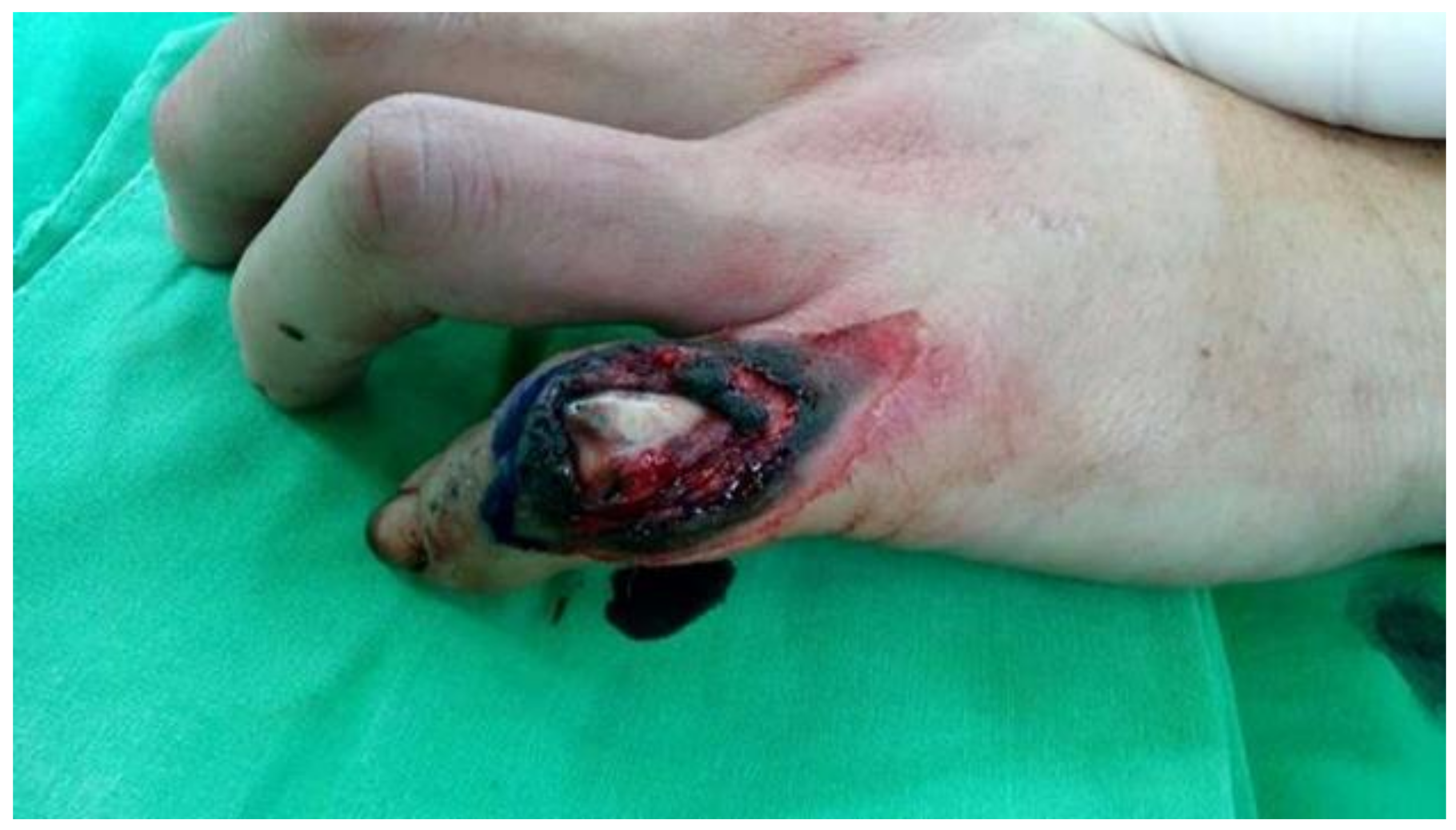
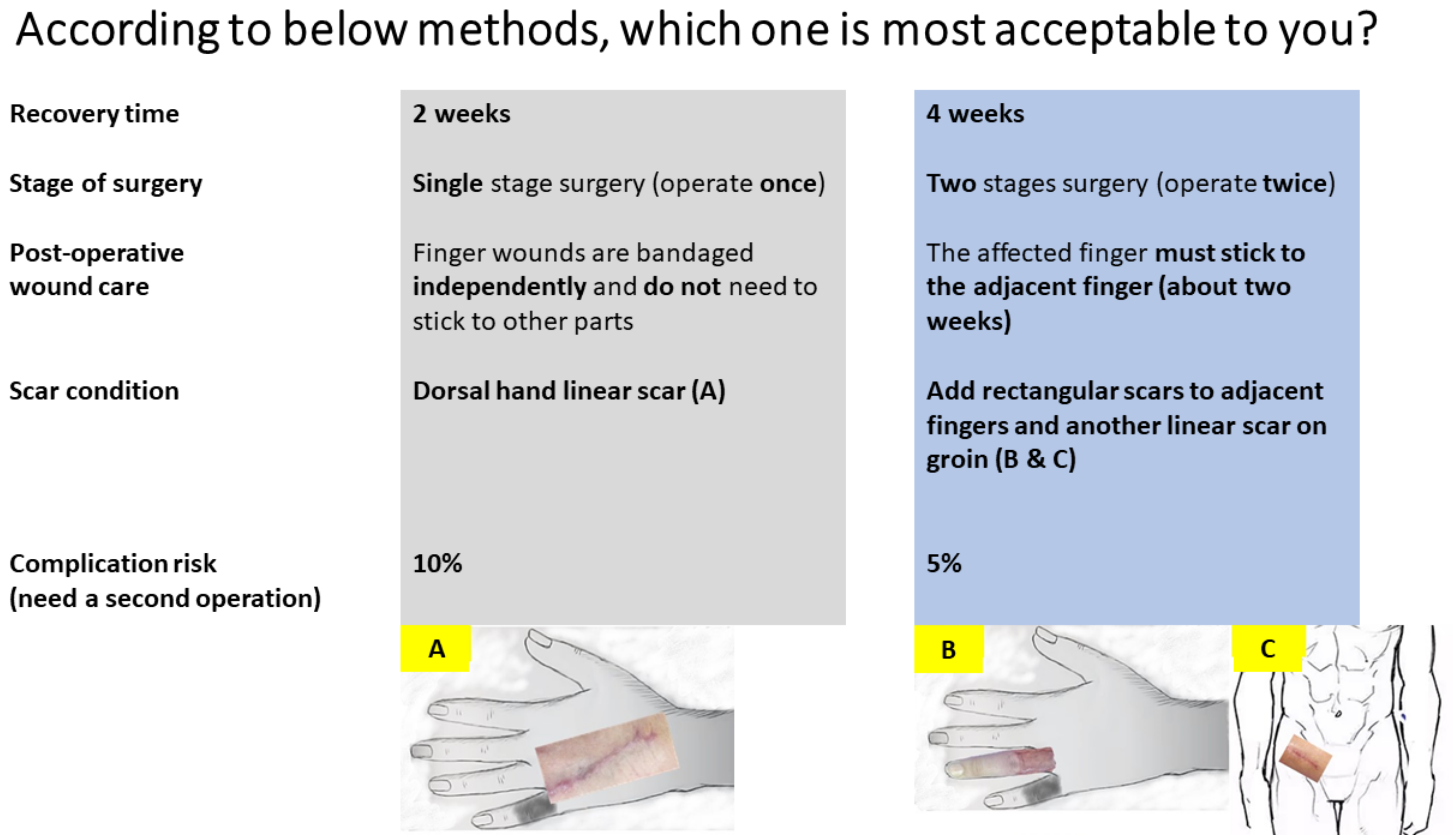
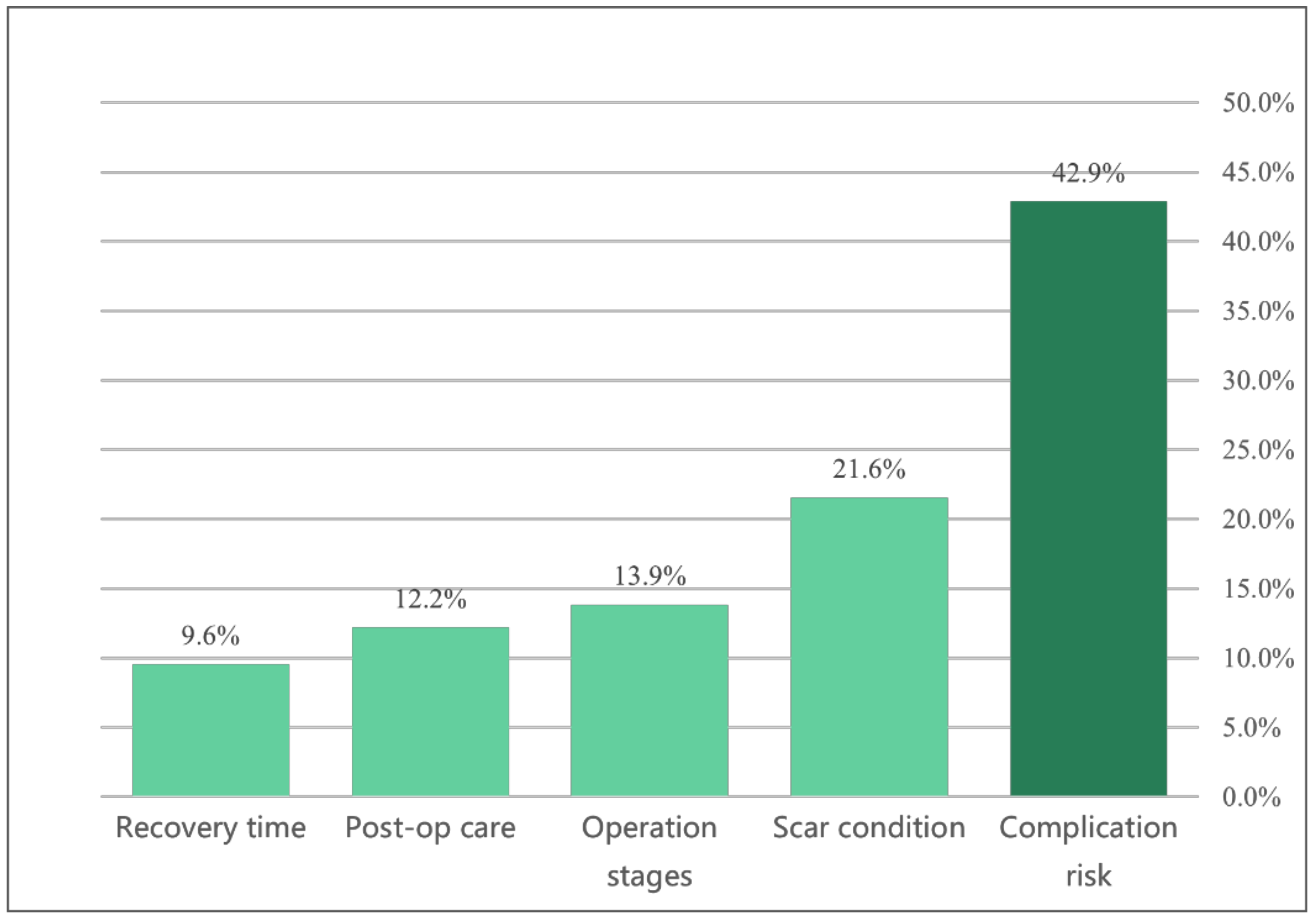


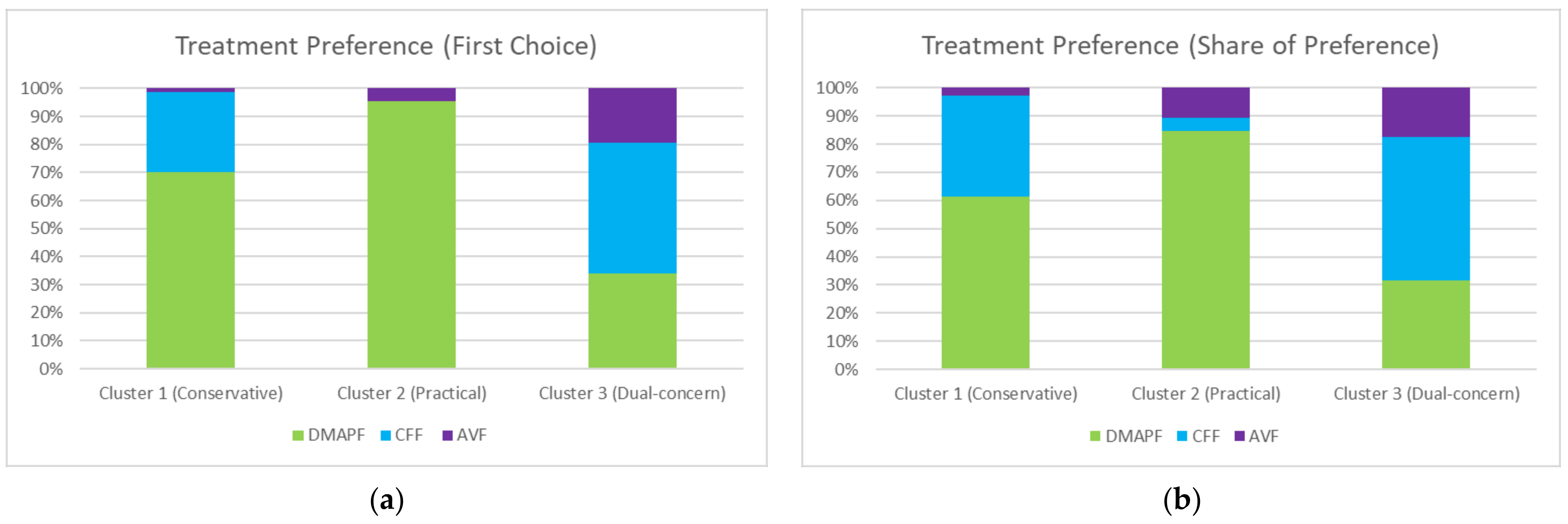
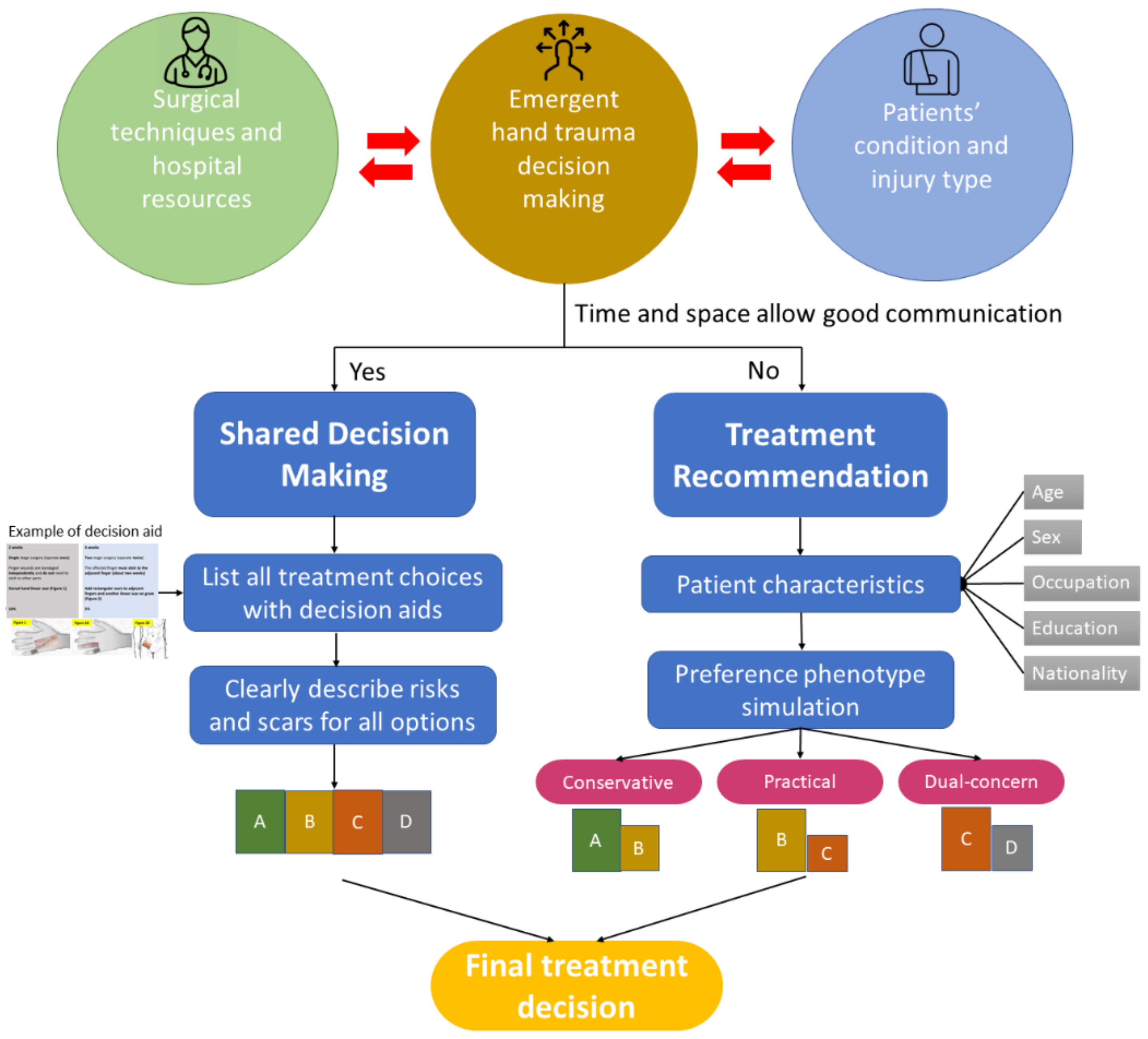
| Attribute | Level 1 | Level 2 | Level 3 |
|---|---|---|---|
| Recovery time | 2 weeks | 4 weeks | |
| Total procedures | One stage | Two stage | |
| Postoperative care methods | Two fingers stuck together (2 weeks) | Each finger cared for independently | |
| Postoperative scar condition | Dorsal hand linear scar | Square-shaped scar at the finger + groin scar | Forearm linear scar |
| Complication rate | 1% | 5% | 10% |
| Characteristics (N = 197) | n (%) |
|---|---|
| Sex | |
| Male | 143 (72.6) |
| Female | 54 (27.4) |
| Age | |
| 20–29 | 38 (19.3) |
| 30–39 | 43 (21.8) |
| 40–49 | 39 (19.8) |
| 50–59 | 43 (21.8) |
| 60–69 | 24 (12.2) |
| >70 | 10 (5.1) |
| Foreign nationality | 18 (9.1) |
| Vietnamese | 15 (83.3) |
| Indonesian | 1 (5.6) |
| Burmese | 2 (11.1) |
| Education level | |
| Elementary school | 12 (6.1) |
| Junior high school | 39 (19.8) |
| High school | 81 (41.1) |
| University (college) | 55 (27.9) |
| Graduate school and above | 10 (5.1) |
| Occupation | |
| Service industry | 63 (32.0) |
| Worker and farmer | 101 (51.3) |
| Student | 6 (3.0) |
| No job or retired | 27 (13.7) |
| Hand injury type | |
| Laceration | 61 (31.0) |
| Only skin defect | 34 (17.3) |
| Skin defect + tendon rupture | 52 (26.4) |
| Skin defect + tendon rupture + fracture | 31 (15.7) |
| Only fracture | 19 (9.6) |
| Experience of skin graft or flap | 39 (19.8) |
| Attributes and Levels | Average Utility (Range) | Attribute Importance %(SD) |
|---|---|---|
| Recovery time | 9.55 (10.51) | |
| 2 weeks | 12.61(−101.82 to 101.08) | |
| 4 weeks | −12.61 (−101.08 to 101.82) | |
| Total procedures | 13.86 (11.99) | |
| Once | 30.01(−85.20 to 161.28) | |
| Twice | −30.01(−161.28 to 85.20) | |
| Postoperative care methods | 12.17 (10.74) | |
| Connected two fingers | −26.55 (−118.88 to 69.16) | |
| Independent | 26.55 (−69.16 to 118.88) | |
| Postoperative scar condition | 21.55 (15.27) | |
| Finger and groin scar | 1.63 (−213.12 to 174.97) | |
| Finger and forearm scar | 1.5 (−139.41 to 122.49) | |
| Dorsal hand linear scar | −3.24 (−191.49 to 279.07) | |
| Complication rates | 42.87 (17.38) | |
| 1% | 87.28 (−138.49 to 257.91) | |
| 5% | 17.68 (−137.57 to 255.95) | |
| 10% | −104.97 (−229.34 to 105.27) |
| Characteristics | Cluster 1 (n = 100) Conservative | Cluster 2 (n = 46) Practical | Cluster 3 (n = 51) Dual-Concern | Total | p-Value |
|---|---|---|---|---|---|
| Age | 43.6 ± 14.3 | 46.2 ± 17.2 | 44.1 ± 14.5 | 44.1 | 0.606 |
| Sex | 0.330 | ||||
| Male | 68 (68.0) | 35 (76.1) | 40 (78.4) | 143 | |
| Female | 32 (32.0) | 11 (23.9) | 11 (21.6) | 54 | |
| Nationality | 0.010 | ||||
| Local | 95 (95.0) | 43 (93.5) | 41 (80.4) | 179 | |
| Foreign | 5 (5.0) | 3 (6.5) | 10 (19.6) | 18 | |
| Education | 0.041 | ||||
| High school/below | 59 (59.0) | 33 (71.7) | 40 (78.4) | 132 | |
| College/above | 41 (41.0) | 13 (28.3) | 11 (21.6) | 65 | |
| Occupation | 0.086 | ||||
| Blue collar | 45 (45.0) | 24 (52.2) | 32 (62.7) | 101 | |
| White collar | 37 (37.0) | 13 (28.3) | 13 (25.5) | 63 | |
| Student | 12 (12.0) | 9 (19.6) | 6 (11.8) | 26 | |
| None | 6 (6.0) | 0 | 0 | 6 | |
| Experience | 0.094 | ||||
| Graft or flap | 15 (15.0) | 14 (30.4) | 10 (19.6) | 39 | |
| Others | 85 (85.0) | 32 (69.6) | 41 (80.4) | 158 |
Publisher’s Note: MDPI stays neutral with regard to jurisdictional claims in published maps and institutional affiliations. |
© 2021 by the authors. Licensee MDPI, Basel, Switzerland. This article is an open access article distributed under the terms and conditions of the Creative Commons Attribution (CC BY) license (https://creativecommons.org/licenses/by/4.0/).
Share and Cite
Chang, D.-H.; Wang, Y.-H.; Hsieh, C.-Y.; Chang, C.-W.; Chang, K.-C.; Chen, Y.-S. Incorporating Patient Preferences into a Decision-Making Model of Hand Trauma Reconstruction. Int. J. Environ. Res. Public Health 2021, 18, 11081. https://doi.org/10.3390/ijerph182111081
Chang D-H, Wang Y-H, Hsieh C-Y, Chang C-W, Chang K-C, Chen Y-S. Incorporating Patient Preferences into a Decision-Making Model of Hand Trauma Reconstruction. International Journal of Environmental Research and Public Health. 2021; 18(21):11081. https://doi.org/10.3390/ijerph182111081
Chicago/Turabian StyleChang, Dun-Hao, Yu-Hsiang Wang, Chi-Ying Hsieh, Che-Wei Chang, Ke-Chung Chang, and Yo-Shen Chen. 2021. "Incorporating Patient Preferences into a Decision-Making Model of Hand Trauma Reconstruction" International Journal of Environmental Research and Public Health 18, no. 21: 11081. https://doi.org/10.3390/ijerph182111081
APA StyleChang, D.-H., Wang, Y.-H., Hsieh, C.-Y., Chang, C.-W., Chang, K.-C., & Chen, Y.-S. (2021). Incorporating Patient Preferences into a Decision-Making Model of Hand Trauma Reconstruction. International Journal of Environmental Research and Public Health, 18(21), 11081. https://doi.org/10.3390/ijerph182111081







